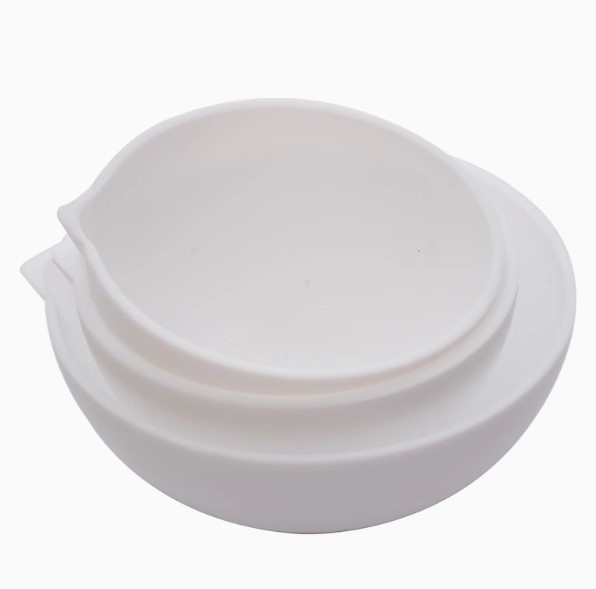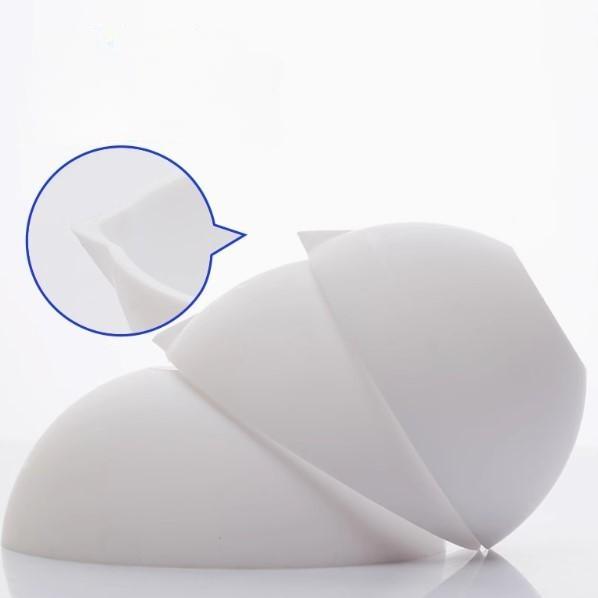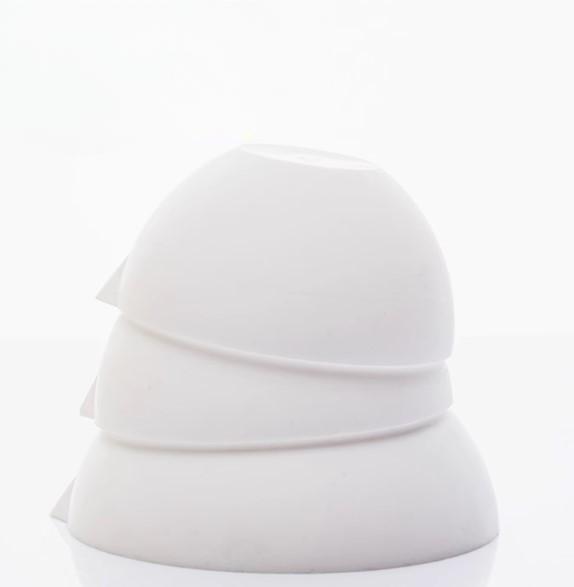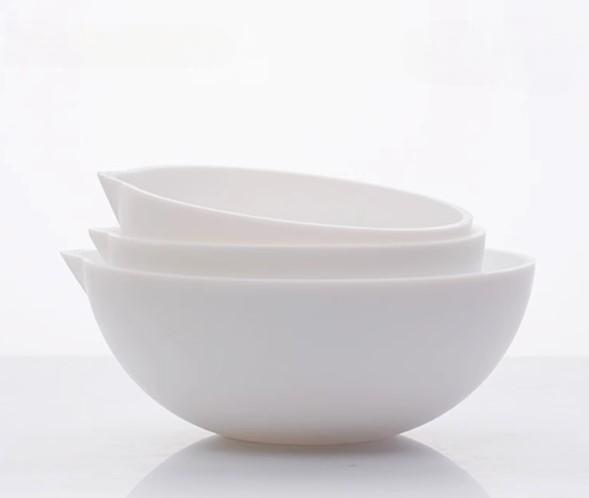
PTFE(Teflon) Labware
Custom PTFE Evaporating Dishes for Diverse Applications
Item Number : PL-1004
Price varies based on specs and customizations
- Capacity
- 30~5000 mL
- Height
- 47~143 mm
- Inner Diameter
- 37~106 mm

Shipping:
Contact us to get shipping details Enjoy On-time Dispatch Guarantee.
Why Choose Us
Reliable PartnerEasy ordering process, quality products, and dedicated support for your business success.
Product Overview
Our Polytetrafluoroethylene (PTFE) evaporating dishes, also commonly known as Teflon dishes, are essential labware designed for a multitude of applications requiring exceptional chemical resistance and thermal stability. These high-purity dishes are meticulously crafted to meet the demanding needs of laboratory and industrial environments.
As shown in the images, these white, opaque dishes feature a classic semi-spherical design with a smooth, non-stick surface. A prominent, well-formed pouring spout is integrated into the rim, facilitating easy and controlled decanting of liquids. The dishes are available in various sizes, often designed to be nestable for convenient and space-saving storage. Their robust construction ensures durability and longevity even under rigorous use.



Key Features and Material Properties
-
Material: High-purity, virgin Polytetrafluoroethylene (PTFE).
-
Appearance: White, opaque, with a very smooth surface finish.
-
Design: Semi-spherical bowl shape with a convenient pouring spout.
-
Surface: Non-stick, hydrophobic, and easy to clean.
-
Construction: Robust and durable, resistant to physical damage.
Applications and Uses
PTFE evaporating dishes are indispensable tools across a wide range of scientific and industrial fields:
-
Laboratory Evaporation: Ideal for evaporating solutions to concentrate solutes or to obtain solid residues.
-
Chemical Handling: Safely handle highly corrosive substances, including strong acids (e.g., hydrofluoric acid, aqua regia), bases, and organic solvents.
-
Sample Preparation: Used in analytical chemistry for sample drying, ashing (at lower temperatures than porcelain), and general sample preparation.
-
High-Purity Work: Suitable for trace metal analysis and applications where contamination is a critical concern.
-
Industrial Processes: Utilized in chemical processing, pharmaceutical development, semiconductor manufacturing, and materials research where inertness and purity are vital.
Advantages of PTFE Evaporating Dishes
Choosing our PTFE evaporating dishes offers significant benefits:
-
Superior Chemical Inertness: Virtually unaffected by most known chemicals and solvents, ensuring sample integrity and preventing dish degradation.
-
Wide Temperature Range: Excellent thermal stability, usable continuously at temperatures from approximately -200°C up to +260°C (-328°F to +500°F).
-
Non-Stick & Easy to Clean: The inherently non-stick surface prevents sample adhesion, allowing for complete sample recovery and effortless cleaning.
-
Durability & Safety: Unlike glass or ceramic alternatives, PTFE is non-breakable, reducing the risk of accidents and the cost of replacements.
-
Hydrophobic Nature: Repels water, minimizing residual moisture and aiding in complete drying of samples.
-
Low Extractables: Contributes negligible impurities, making it ideal for sensitive analyses.
Value to Our Customers
By incorporating these PTFE evaporating dishes into your workflow, you can:
-
Enhance Experimental Accuracy: Minimize the risk of sample contamination or reaction with the container.
-
Improve Laboratory Safety: Reduce breakage hazards associated with fragile labware.
-
Increase Efficiency: Save time with easy-to-clean, non-stick surfaces and ensure maximum sample recovery.
-
Achieve Versatility: Utilize a single type of dish for a broad spectrum of aggressive chemicals and thermal conditions.
-
Optimize Resources: Benefit from the long service life and reusability of these durable dishes.
-
Access Tailored Solutions: We offer customization to meet specific size, design, or application requirements, ensuring a perfect fit for your unique needs.
Connect With Us
Whether you require standard sizes or have a unique specification for custom-manufactured PTFE evaporating dishes, our team is ready to provide the optimal solution for your application. We are committed to delivering high-quality PTFE products that enhance your operational efficiency and research outcomes.
To discuss your specific needs or to request a quote, please reach out to us via our Contact Form.
Product Specifications
| Capacity (mL) | Height (mm) | Inner Diameter (mm) |
| 50 | 40 | 80 |
| 100 | 47 | 91 |
| 150 | 46 |
105 |
FAQ
What Are The Main Applications Of PTFE Discs?
What Are The Common Applications Of PTFE Barrels?
What Are The Main Applications Of PTFE Gaskets?
What Are The Main Applications Of PTFE Parts?
What Are The Main Applications Of Teflon Seals?
What Are The Main Applications Of PTFE Components?
What Are The Main Applications Of PTFE Labware?
What Are The Main Applications Of PTFE Glands?
What Are The Main Applications Of PTFE Rings?
What Are The Key Features Of PTFE Discs?
What Are The Key Features Of PTFE Barrels?
What Are The Key Features Of PTFE Gaskets?
What Are The Key Features Of PTFE?
What Are The Key Features Of Teflon Seals?
What Are The Key Features Of PTFE Components?
What Are The Key Features Of PTFE Labware?
What Are The Key Features Of PTFE Glands?
What Are The Key Features Of PTFE Rings?
How Do PTFE Discs Work In Sealing Applications?
How Does A PTFE Lined Butterfly Valve Work?
What Is The Principle Behind PTFE Gaskets?
How Do PTFE O-ring Seals Work?
How Do Teflon Seals Work In Harsh Environments?
What Are The Key Components Of PTFE (Polytetrafluoroethylene)?
What Makes PTFE Suitable For Labware?
How Are PTFE Rings Manufactured?
What Are The Advantages Of Using PTFE Discs?
What Are The Advantages Of Using PTFE Barrels?
What Are The Advantages Of Using PTFE Gaskets?
What Are The Advantages Of Using PTFE Parts?
What Are The Advantages Of Using Teflon Seals?
What Are The Advantages Of Using PTFE Components?
What Are The Advantages Of Using PTFE Labware?
What Are The Advantages Of Using PTFE Glands?
What Are The Advantages Of Using PTFE Rings?
Why Are PTFE Discs Preferred In High-temperature Environments?
Why Are PTFE Barrels Suitable For Laboratory Use?
How Are PTFE Gaskets Installed?
Why Is PTFE Suitable For CNC Machining?
Are Teflon Seals Environmentally Friendly?
Why Are PTFE Components Ideal For Chemical And High-temperature Applications?
What Types Of PTFE Labware Are Available?
Are Custom PTFE Glands Available For Specific Applications?
Why Are PTFE Rings Preferred In The Semiconductor Industry?
Are PTFE Discs Resistant To Chemicals?
What Types Of PTFE Parts Are Commonly Manufactured?
How Do PTFE Components Perform In Cryogenic Conditions?
Are PTFE Rings Suitable For Medical Applications?
What Makes PTFE Discs Non-stick?
Can PTFE Discs Be Used In Electrical Applications?
How Do PTFE Discs Perform In Low-temperature Environments?
Are PTFE Discs Customizable For Specific Applications?
4.8
out of
5
Incredible quality! These dishes withstand high temps without a hitch. A lab essential!
4.7
out of
5
Fast delivery and perfect fit for our needs. Worth every penny!
4.9
out of
5
Durable and precise. These PTFE dishes are a game-changer for our lab work.
4.8
out of
5
Superior craftsmanship. They handle corrosive materials like a dream.
4.7
out of
5
Great value! These dishes outlasted our previous ones by months.
4.9
out of
5
Tech-forward design. Perfect for high-precision evaporation tasks.
4.8
out of
5
Lightweight yet sturdy. A must-have for any serious researcher.
4.7
out of
5
Arrived sooner than expected. Performance is flawless—highly recommend!
4.9
out of
5
Exceptional durability. These dishes are built to last through rigorous use.
4.8
out of
5
Precision-engineered and reliable. A top-tier lab investment.
4.7
out of
5
Affordable excellence. These dishes outperform pricier competitors.
4.9
out of
5
Innovative material use. They resist stains and chemicals effortlessly.
4.8
out of
5
Consistent results every time. A reliable tool for critical experiments.
4.7
out of
5
Quick shipping and impeccable quality. Will order again!
4.9
out of
5
Perfect for diverse applications. These dishes are a lab’s best friend.
REQUEST A QUOTE
Our professional team will reply to you within one business day. Please feel free to contact us!
Related Products

PTFE Deep Evaporating Dishes Customizable Laboratory and Industrial Solutions
High-quality PTFE deep evaporating dishes for labs. Chemical-resistant, non-stick, and customizable. Ideal for sample handling. Get yours now!

Custom PTFE Shallow Evaporating Dishes for Diverse Applications
High-purity PTFE shallow evaporating dish for labs. Chemical-resistant, non-stick, ideal for sample evaporation. Custom sizes available. Order now!

Custom PTFE Parts Manufacturer for Teflon Parts and PTFE Tweezers
KINTEK prioritizes precision production and offers custom fabrication from prototypes to high-volume orders.

Custom PTFE Measuring Cylinders for Advanced Scientific and Industrial Applications
Discover the superior performance of our Polytetrafluoroethylene (PTFE) measuring cylinders, engineered for precision and resilience in demanding environments.

PTFE Chemical Solvent Sampling Spoon
Discover our high-purity PTFE (Polytetrafluoroethylene, commonly known as Teflon) Sampling Spoons, meticulously engineered for the safe, precise, and contamination-free handling of chemicals, solvents, powders, and various samples.

Customizable PTFE Crucibles for Laboratory and Industrial Applications
High-purity PTFE crucibles with lids for labs. Chemical-resistant, non-stick, and durable. Ideal for sample digestion, AA, ICP-MS. Custom sizes available.

Custom PTFE Parts Manufacturer for Teflon Containers and Components
High-precision PTFE containers for labs & industry. Chemical-resistant, customizable sizes. Ideal for semiconductor, medical & lab applications. Get a quote!

Customizable PTFE Three Neck Flasks for Advanced Chemical Applications
Our high-performance Three-Neck Round-Bottom Flasks are expertly crafted from pure Polytetrafluoroethylene (PTFE), a material renowned for its exceptional properties, making it ideal for demanding laboratory and industrial environments.

Custom PTFE Square Trays for Industrial and Laboratory Use
Premium PTFE square trays for labs & industry. Chemical-resistant, non-stick, high-purity PTFE trays for semiconductors & medical use. Custom sizes available.

Custom PTFE Bottles for Diverse Industrial Applications
High-purity PTFE bottles for chemical storage, resistant to acids & solvents. Wide/narrow mouth options, leak-proof, durable. Ideal for labs & industry.

Customizable PTFE Seals Filter Holders for Versatile Applications
Enhance filtration with KINTEK's PTFE-sealed filter holders for leak-proof, chemical-resistant performance in labs and industries. Explore now!

Custom PTFE Volumetric Flasks for Advanced Scientific and Industrial Use
Premium PTFE volumetric flasks for labs – chemical-resistant, non-stick, precise measurements. Ideal for semiconductor, medical & analytical applications. Shop now!

Custom PTFE Microwave Digestion Vessels for Demanding Applications
High-purity PTFE microwave digestion vessels for safe, contamination-free sample prep. Ideal for ICP-MS, AAS, and trace analysis. Custom sizes available.

Custom PTFE Sleeves and Hollow Rods for Advanced Applications
High-performance PTFE hollow rods & sleeves for chemical resistance, thermal stability, and low friction. Custom sizes available. Contact KINTEK today!

Custom PTFE Teflon Parts Manufacturer PTFE Magnetic Stirring Bar
KINTEK PTFE magnetic stirring bars offer chemical resistance, high-temperature stability, and smooth mixing for labs. Ideal for diverse applications.

Customizable PTFE Rods for Advanced Industrial Applications
High-performance PTFE solid rods for chemical-resistant, low-friction components. Ideal for lab, medical & industrial applications. Custom machining available.

Custom PTFE Teflon Balls for Advanced Industrial Applications
Precision PTFE balls for chemical, medical & industrial use. High-performance, low-friction, chemical-resistant. Custom sizes available. Get a quote today!

Custom PTFE Teflon Parts Manufacturer PTFE Cleaning Rack
High-purity PTFE flower baskets for labs & semiconductor use. Chemical-resistant, -180°C to +250°C, custom sizes available. Contact KINTEK today!

Custom PTFE Teflon Parts Manufacturer Conductive Glass Substrate Cleaning Rack
High-purity PTFE flower baskets for lab cleaning, resistant to chemicals & extreme temps. Custom designs available for semiconductor & medical applications.
Related Articles

The Physics of Failure: Where Metal Fails, PTFE Prevails
PTFE components aren't just parts; they're solutions for high-friction, chemical, and sterile environments where traditional materials fail.

The PTFE Paradox: Why the 'Perfect' Material Fails—And How to Make It Work
Your high-performance parts fail despite using advanced materials like PTFE. Discover the hidden design flaw and how expert fabrication unlocks true reliability.

Beyond 'Non-Stick': The Physics and Psychology of Purity in PTFE Labware
Discover how PTFE's intrinsic molecular properties, not just its surface, prevent sample loss and contamination, ensuring data integrity in critical science.

The Physics of Trust: Why PTFE Is the Bedrock of High-Stakes Electronics
PTFE's value isn't just insulation; its unparalleled electrical and thermal stability provides the trust and reliability essential for 5G, aerospace, and advanced computing.

The Datasheet Said It Was Perfect. So Why Did Your Component Fail?
Discover the hidden reason high-performance components fail despite meeting specs. Learn why a material's combined properties are the key to reliability.

When 'Tougher' Isn't Enough: The Hidden Reason Your Industrial Components Are Failing
Discover why conventional materials fail under combined stress and how PTFE components provide a definitive solution for chemical, thermal, and friction challenges.

When 'Chemically Inert' Isn't Enough: Why Your PTFE Components Fail and How to Prevent It
Discover why even high-quality PTFE components can unexpectedly fail. Learn the hidden chemical exceptions and how to select the right material.

Why 'Medical-Grade' Isn't Enough: The Hidden Risk in Your PTFE Components
Generic 'medical-grade' PTFE poses hidden risks. Discover why material purity and manufacturing precision are the real keys to device safety.

The Unseen Guardian: How PTFE's Molecular Shield Protects Our Most Critical Systems
An engineer's look at PTFE's chemical inertness and thermal stability, and why precision fabrication is key to its reliability.

The Engineer's Dilemma: Navigating the Trade-offs Between PTFE and Its Alternatives
Choosing between PTFE and PTFE-free components isn't about finding a better material, but making a precise engineering decision based on priorities.

The Physics of a Perfect Fit: How PTFE Eliminates an Athlete's Hidden Distractions
Discover how PTFE's unique physics enhances athletic performance by ensuring a secure fit and maintaining traction, eliminating critical distractions.

The Fluorine Fortress: How PTFE's Molecular Simplicity Creates Unrivaled Performance
Discover how PTFE's simple carbon-fluorine bond creates a molecular fortress, leading to extreme chemical inertness and low friction.